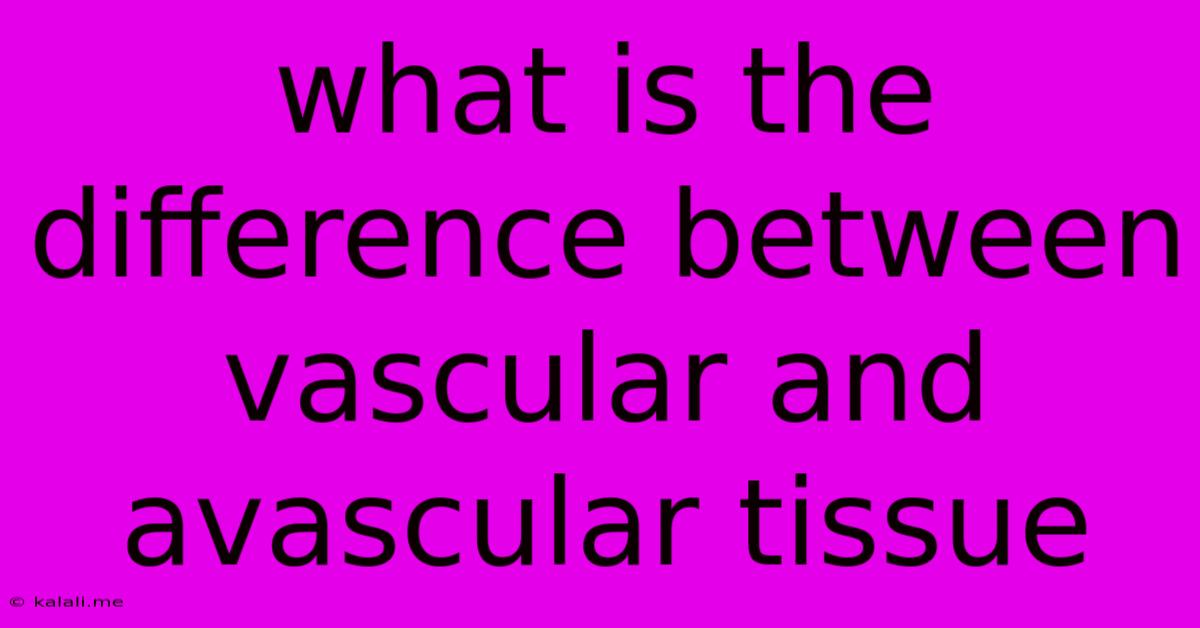What Is The Difference Between Vascular And Avascular Tissue
Kalali
Jun 12, 2025 · 3 min read

Table of Contents
What's the Difference Between Vascular and Avascular Tissue? A Comprehensive Guide
Understanding the difference between vascular and avascular tissue is fundamental to grasping basic biology and the complexities of the human body. This article will explore the key distinctions between these two tissue types, their functions, and examples found within the body. This detailed explanation will help you understand the vital roles these tissues play in maintaining overall health and well-being.
What is Vascular Tissue?
Vascular tissue is characterized by the presence of blood vessels. These vessels, including arteries, veins, and capillaries, transport blood throughout the body. This blood carries essential nutrients, oxygen, hormones, and other vital substances to the cells, while simultaneously removing waste products like carbon dioxide. The rich blood supply enables rapid nutrient delivery and efficient waste removal, supporting high metabolic activity.
Key characteristics of vascular tissue include:
- Abundant blood supply: This is the defining feature.
- High metabolic rate: The constant supply of nutrients fuels efficient cellular processes.
- Rapid healing: The quick delivery of nutrients and immune cells promotes faster repair of damaged tissues.
- Effective waste removal: Metabolic byproducts are swiftly transported away.
Examples of vascular tissue:
- Most organs: Heart, liver, kidneys, lungs, and spleen are highly vascular.
- Skeletal muscle: Requires significant oxygen and nutrient delivery during activity.
- Connective tissue (some types): Certain connective tissues, like the dermis of the skin, are well-vascularized.
What is Avascular Tissue?
Avascular tissue, conversely, lacks a direct blood supply. Nutrients and oxygen must reach these tissues through diffusion from nearby vascular tissues. This process is significantly slower and less efficient than direct blood delivery. Consequently, avascular tissues typically have a lower metabolic rate and slower healing times compared to vascular tissues.
Key characteristics of avascular tissue include:
- Absence of blood vessels: This is the defining characteristic.
- Lower metabolic rate: Nutrient delivery limitations restrict cellular activity.
- Slower healing: Repair processes are hindered by limited nutrient supply.
- Dependence on diffusion: Nutrients and oxygen must travel through surrounding tissues.
Examples of avascular tissue:
- Epithelial tissues: The epidermis (outer layer of skin), cornea, and enamel of teeth are avascular.
- Cartilage: This connective tissue receives nutrients via diffusion from the perichondrium (a surrounding membrane).
- Tendons and ligaments: While containing some blood vessels, these tissues are relatively avascular, leading to slow healing after injury.
Comparing Vascular and Avascular Tissue: A Summary Table
| Feature | Vascular Tissue | Avascular Tissue |
|---|---|---|
| Blood Vessels | Present | Absent |
| Metabolic Rate | High | Low |
| Healing Rate | Fast | Slow |
| Nutrient Delivery | Direct (via blood) | Indirect (via diffusion) |
| Waste Removal | Efficient | Less efficient |
| Examples | Heart, liver, skeletal muscle, dermis | Epidermis, cornea, cartilage, enamel |
Clinical Significance
The difference between vascular and avascular tissue has significant clinical implications. For example, wounds in avascular tissues, like the cornea, heal much slower than wounds in vascular tissues like the skin dermis. Understanding the vascularity of different tissues is crucial for diagnosis, treatment, and prognosis of various medical conditions.
This comprehensive comparison provides a clearer understanding of the differences between vascular and avascular tissues. Recognizing these distinctions is essential for comprehending the diverse functions and complexities of the human body.
Latest Posts
Latest Posts
-
Which Of The Following Is A Nonmetal
Jun 13, 2025
-
What Is Land Surrounded By Water On Three Sides Called
Jun 13, 2025
-
Which Of The Following Is An Essential Fatty Acid
Jun 13, 2025
-
During Which Of The Following Phases Does Dna Replication Occur
Jun 13, 2025
-
Differentiate Between Commercial Farming And Subsistence Farming
Jun 13, 2025
Related Post
Thank you for visiting our website which covers about What Is The Difference Between Vascular And Avascular Tissue . We hope the information provided has been useful to you. Feel free to contact us if you have any questions or need further assistance. See you next time and don't miss to bookmark.